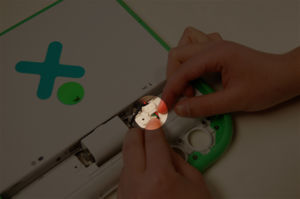XO Troubleshooting Power
| Please copy/paste "{{Translationlist | xx | origlang=en | translated={{{translated}}}}}" (where xx is ISO 639 language code for your translation) to XO Troubleshooting Power/translations | HowTo [ID# 302728] +/- |
Introduction
This is the portion of the XO Troubleshooting Guide for diagnosing battery charging and power supply problems on an XO laptop.
This page details only problems that actually reside outside of the battery, inside the laptop. Note that if you are having problems running an XO from battery power, or having problems charging a battery, such problems could be the fault of the battery (the laptop itself may be fine). Problems that are localised to the battery itself are discussed at XO Troubleshooting Battery.
How can you tell whether a particular problem is due to a faulty battery or faulty laptop? This is easiest when you have two XOs. Let's say you have laptop A including battery A, which is exhibiting a problem. You also have laptop B with laptop B, which is your personal XO which you trust to be functioning well. Take battery A and place it in laptop B, and take battery B and put it in laptop A. Testing both laptops will then give you a strong indication as to where the problem resides. Does the problem "follow" battery A into laptop B? If so, the problem resides within the battery (head over to XO Troubleshooting Battery). Or does the problem remain within laptop A even when running from battery B? In such case, the problem resides within the laptop (you're on the right page).
If you only have one XO available to you, it is suggested that you have a quick read of both this page and XO Troubleshooting Battery. You should be able to make an educated guess as to which page is the most appropriate for your problem. If in doubt, follow the diagnostics outlined on both pages.
Troubleshooting
Did the EC boot?
Follow the Full Reset procedure, and check to see if the battery LED flashes orange momentarily after reapplying one source of power. The flash is very brief, less than half a second, and occurs only once each time the first source of power is applied.
If it didn't flash at all, you probably have a broken motherboard.
If it flashed another color (red or green), then you probably have a problem with the LED or LED driver circuitry.
To check the EC is running properly, try removing the battery and powering up the laptop without it. Replace the battery after the laptop is running.
The laptop emits a high pitched whine when using the power adapter
The whine is usually the result of lower-than-normal input voltage or current from the external adapter, e.g. charging with the portable PV panel. The whine comes from vibration in the coils in the inductor -- if the whine is extreme, and goes on for a very long time, there's some chance of the insulating varnish on the coils being harmed, but for all practical purposes, the whine is perfectly safe.
Laptop recognizes the battery, reads its charge percent & voltage properly but does not charge it
You may see cases where the laptop does not work without AC power, despite having a good, fully-charged battery inserted. When powering on the laptop, you may see the power & battery LEDs toggle continiously while the power on button is pressed. Despite this, the laptop will otherwise appear to work normally.
Solution (XO-1): This problem can be fixed by replacing the Q32 component on the motherboard; it's a transistor wich drains power to/from battery when charging/discharging.
If the laptop can't run from a known good power source
If the laptop can't run from a known good power source:
- Does the battery charge LED indicate the laptop thinks it has power? With a battery inserted, the battery LED should turn yellow or green within a minute of applying power. In this case, the laptop probably has a startup problem, not a power problem.
- Otherwise, the motherboard needs replacement.
- Suspect components are the fuse F1 (2A) and diode D21 (3A schottky) on the motherboard protecting the DC input. If the fuse was blown, check diode D123 (3A schottky) and diode D118 (38V zener) to see if they are OK.
- For XO 1.5 rev G schematic: Page 27 "CHARGER" is what you need. PF1 is a fuse. If it is conducting in both directions, then it has probably not opened. Check voltage at test point VAD, on the cathode of PD27 and PD26. That will help identify if PD23 and PD24 are taking current after failure. You could also measure the current drawn through the cable with the battery removed and the laptop turned off.
Common causes for lack of battery presence
There are a number of possible causes for lack of battery presence. Here they are, in the order in which they should be checked.
Unplugged cable
Check to see that connectors CN21 (shown in picture) and CN22 on the motherboard are firmly plugged in. CN21 has a second connector, hidden in the bottom part of the laptop.
Broken Wire
If no batteries are detected, a break or bad connection between CN22 on the motherboard and the data pin on the battery connector results in no 1-wire communication (seen as this problem). Check continuity of the cable with an ohm meter.
